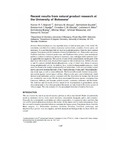Please use this identifier to cite or link to this item:
http://hdl.handle.net/10311/308| Title: | Recent results from natural product research at the University of Botswana |
| Authors: | Majinda, R.R.T Abegaz, B.M. Bezabih, M. Ngadjui, B.T Wanjala, C.C.W. Mdee, L.K. Bojase, G. Silayo, A. Masesane, I. Yeboah, S.O. |
| Keywords: | Dorstenia species Rhus pyroides Bolusanthus speciosus Erythrina latissima Crotalaria podocarpa Elephantorrhiza goetzei |
| Issue Date: | 2001 |
| Publisher: | IUPAC. http://www.iupac.org/publications/pac/ |
| Citation: | Majinda, R.R.T. et al (2001) Recent results from natural product research at the University of Botswana, Pure and Applied Chemistry, vol. 73, pp. 1197–1208 |
| Abstract: | Marketed plants are very important items of trade in many parts of the world. The community uses these for a variety of purposes such as foods, cosmetics, flavors, spices, and medicines. It seems that plants that are used for medicinal purposes form the most common category. Four plants used for treatment of microbial infections, viz., Bolusanthus speciosus, Erythrina latissima, Crotalaria podocarpa, and Elephantorrhiza goetzei, were investigated, and these yielded several known and novel structures, some with appreciable antibiotic activity against the test organisms. The activity of some of the isolated plants and the parts of the plant from which these were obtained lend support to their traditional use. Bulbine abyssinica and B. capitata yielded phenylanthraquinones, some of which were shown to possess strong antiplasmodial activity. In addition, these yielded isofuranonaphthoquinones, which were also found to be weakly antiplasmodial and antioxidant. Scilla nervosa yielded several known and novel homoisoflavoinds of the 3-benzylchroman-4-ones and 3-benzylidinechroman- 4-one type, as well as some stilbenoids. The homoisoflavonoids showed strong antitumor activity against various cancer cell lines. Rhus pyroides gave a novel bichalcone, which showed weak antifeedant activity, consistent with the observation by farmers that the plant was avoided by corn cricket. Results from investigated Dorstenia species originating from Cameroon, Ethiopia, and Tanzania yielded styrenes, coumarins, chalcones, and flavonoids. The chalcones and flavonoids showed various levels of prenylation or geranylation, and an observation made so far is that prenylated flavonoids are only found in Dorstenia species of African origin. The only example of a bis-geranylated chalcone is found in Dorstenia. |
| URI: | http://hdl.handle.net/10311/308 |
| ISSN: | 1365-3075 |
| Appears in Collections: | Research articles (Dept of Chemistry) |
Files in This Item:
| File | Description | Size | Format | |
|---|---|---|---|---|
| Recent results from.pdf | 4.52 MB | Adobe PDF |  View/Open |
Items in DSpace are protected by copyright, with all rights reserved, unless otherwise indicated.
